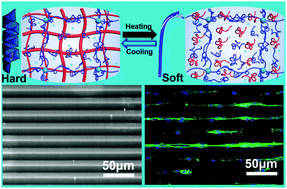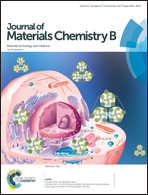Robust and thermoplastic hydrogels with surface micro-patterns for highly oriented growth of osteoblasts†
Abstract
Biocompatible hydrogels with high strength, high precision patterns, and arbitrary 3D shapes are extremely desired soft platforms in the biomedicine fields. On the basis of the thermal-reversible sol–gel transition of agarose and the formation of nanofibers below 35 °C, a robust and thermoplastic hydrogel (TPG) was fabricated by in situ polymerization of acrylamide in the agarose matrix. The tensile fracture stress/strain values of the TPG were unexpectedly higher than those of both agarose and polyacrylamide hydrogels as a result of the double networks reinforced with nanofibers. The TPG could reversibly soften and harden by heating and cooling treatment, respectively, leading to an excellent mechanical recoverability and reprocessing ability. Thus, arbitrary 3D-shaped hydrogels and micro-patterns embossed on the TPG surface with a high resolution of 1 μm were constructed. The rigid TPG exhibited a remarkable affinity for the adhesion and proliferation of cells. In particular, the TPGs with microgrooves could highly guide the oriented growth of osteoblasts, showing potential applications in the field of tissue engineering.



 Please wait while we load your content...
Please wait while we load your content...